Crispy Latkes
- By Jennifer Segal
- Updated September 18, 2025
- 302 Comments
- Leave a Review

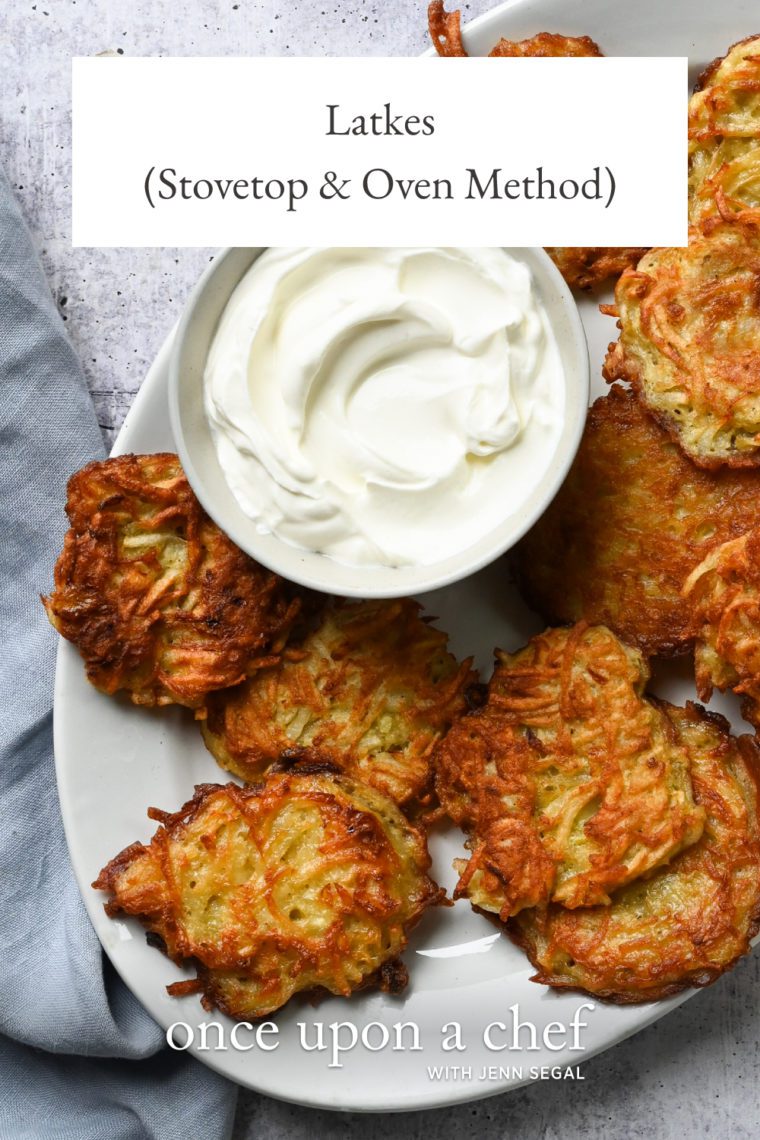
This post may contain affiliate links. Read my full disclosure policy.
These crispy, golden latkes are a classic Hanukkah favorite. Whether you prefer the traditional stovetop method or the mess-free oven method, this latkes recipe makes it easy to enjoy delicious potato pancakes anytime.
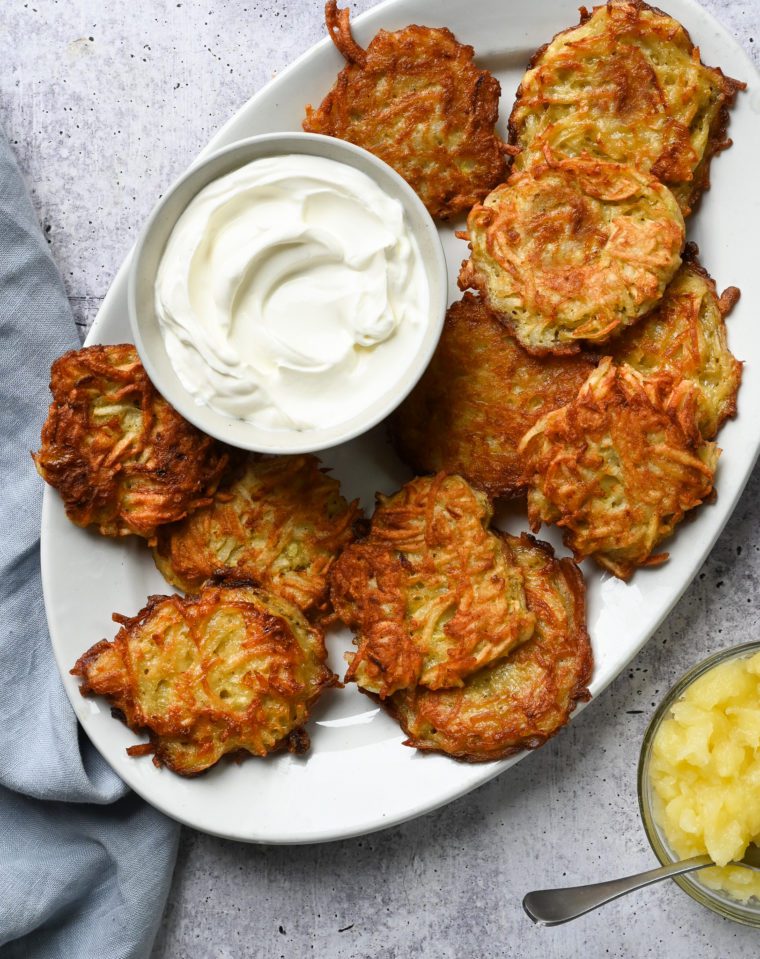
Latkes are traditionally eaten during the Jewish holiday of Hanukkah, when it’s customary to eat foods fried in oil. At any Hanukkah party, you’ll likely find an apron-clad Jewish mother standing at the stove frying up these onion-scented potato pancakes. This tradition can be fun, but it can also be messy and hectic with hot oil splattering all over the stove and children running underfoot. That’s why I was thrilled to discover that potato latkes can also be fried in the oven!
This recipe offers two methods: the quick stovetop method, which requires cooking in batches, and the oven method, which takes longer but cooks all the latkes at once and is less messy.
Traditionally, latkes are served with applesauce and sour cream—and honestly, it doesn’t get much better than that. But there are plenty of other delicious toppings and sides you can try. Smoked salmon with sour cream or crème fraîche feels festive, fresh herbs like chives or dill add brightness, and if you want to get fancy, a little caviar takes them over the top.
For a complete meal, pair latkes with roast chicken or brisket, a crisp green salad, or a simple bowl of chicken noodle soup.
“These turned out great! I used the oven method and they were so crispy and delicious!”
What You’ll Need To Make Potato Latkes
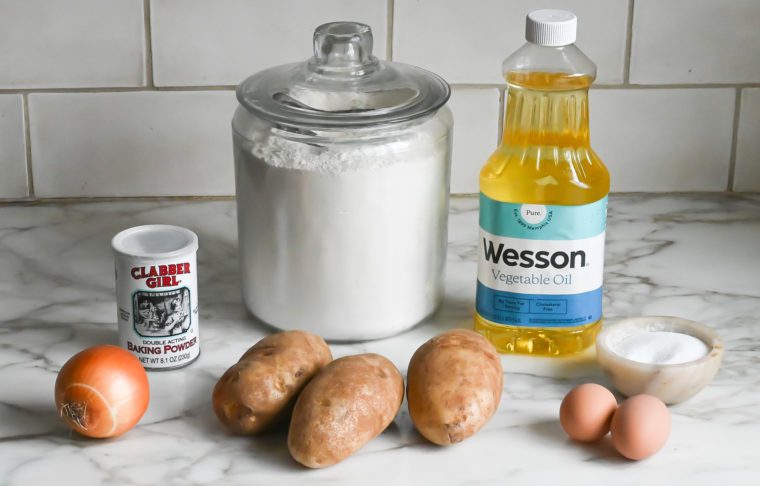
- Russet Potatoes: These starchy potatoes are perfect for latkes, giving them a crispy exterior and fluffy interior.
- Yellow Onion: Adds a subtle sweetness and depth of flavor.
- Eggs: Help bind the ingredients together, ensuring the latkes hold their shape when frying.
- Salt: Enhances the flavors of the potatoes and onions.
- All-Purpose Flour & Baking Powder: The flour helps absorb moisture and the baking powder adds a bit of lift, making the latkes light and crisp.
- Vegetable Oil: Used for frying.
- Jump to the printable recipe for precise measurements
Step-By-Step Instructions
Step 1: Prep the potatoes. Peel the potatoes, then grate them along with the onion—either in a food processor (fast and easy) or by hand with a box grater if you don’t mind a little workout.
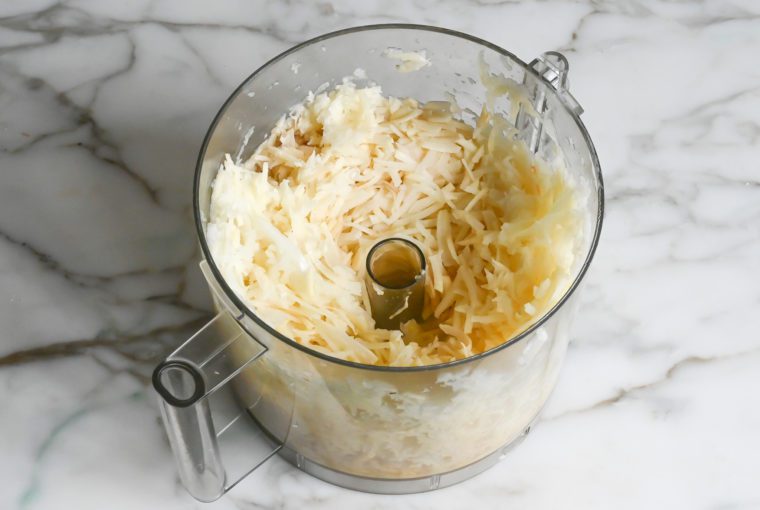
Step 2: Squeeze out the liquid. Transfer the potato-onion mixture to a fine sieve set over the sink or a large bowl. Use a wad of paper towels or a clean dish towel to press down firmly and wring out as much liquid as you can—the drier the mixture, the crispier your latkes will be.
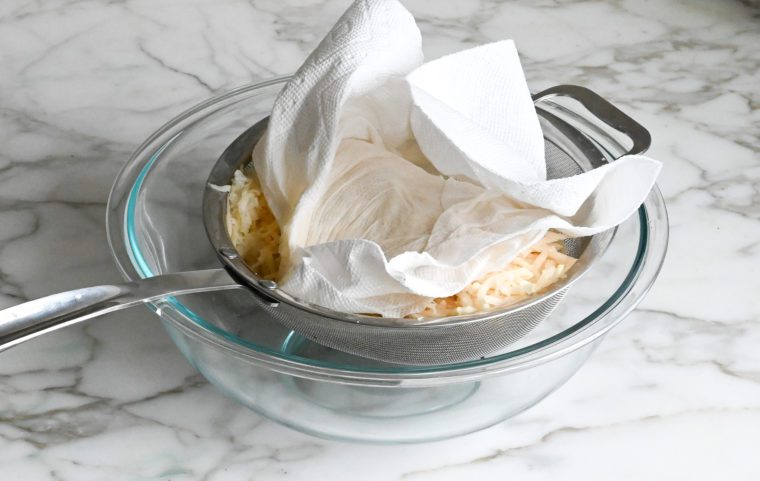
Step 3: Mix it all together. In a large bowl, beat the eggs, then add the potato-onion mixture along with the salt, baking powder, and flour. Stir until everything is evenly combined and the potatoes are well coated.
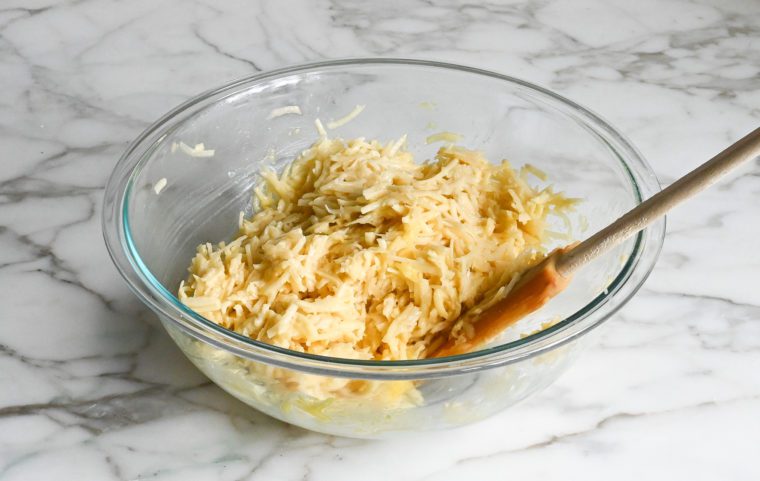
Step 4: Fry the latkes. You can cook them on the stovetop or in the oven—see instructions below for each method.
Stovetop method: Heat about ¼ cup of oil in a large cast-iron or nonstick skillet over medium-high heat. Scoop mounds of the potato mixture into the hot oil and gently flatten them with a spatula. Turn the heat down a bit and cook until the bottoms are golden and crispy. Flip and cook until the second side is golden, another 4 to 5 minutes.
Oven method: Preheat the oven to 425°F and position two racks in the center. Pour ½ cup oil into each of two heavy, rimmed nonstick baking sheets and slide them into the oven for about 10 minutes to heat. Carefully pull the hot pans out, drop mounds of batter onto the sheets, and flatten them slightly. Bake for 15 to 20 minutes, until the bottoms are golden. Remove the pans, flip the latkes, and bake for another 10 minutes or so, until they’re crisp and golden all over.
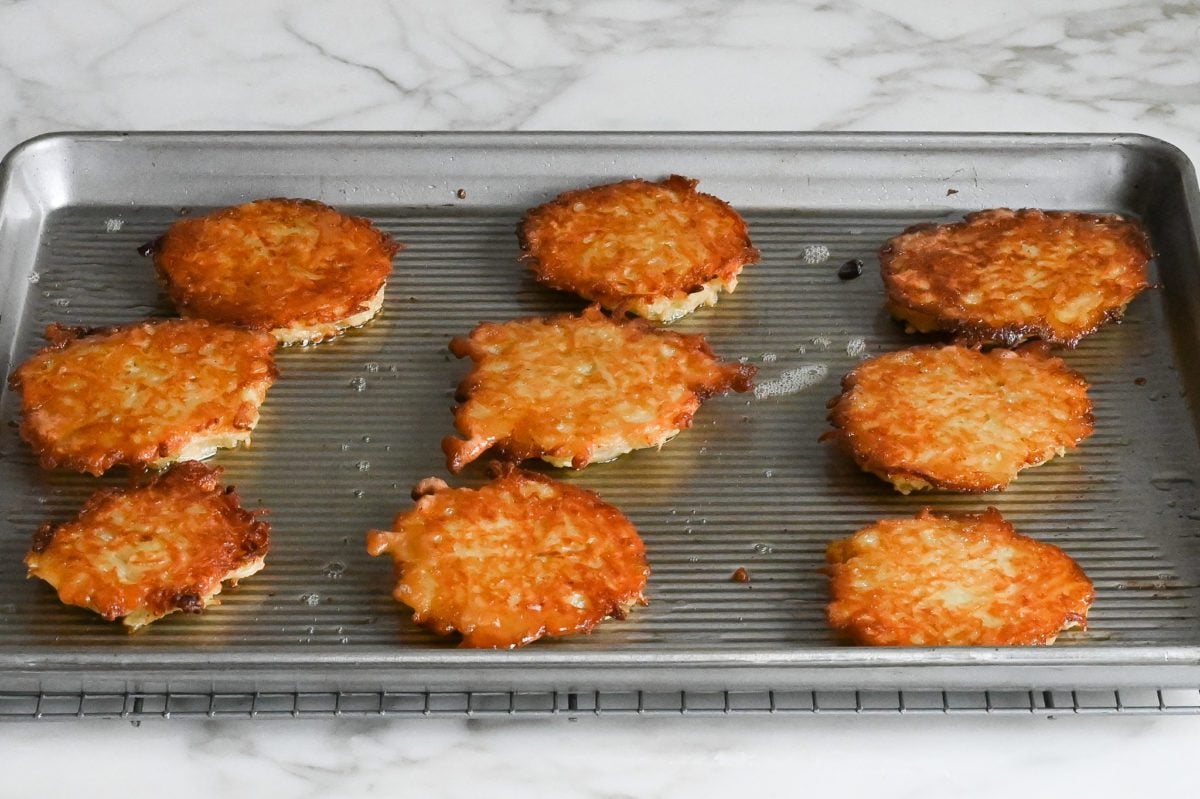
Step 5: Drain and serve. Once the latkes are done—whether fried on the stovetop or baked in the oven—transfer them to a paper towel–lined plate to drain. Latkes are at their best hot and fresh, but they also reheat beautifully and can even be frozen for up to three months.
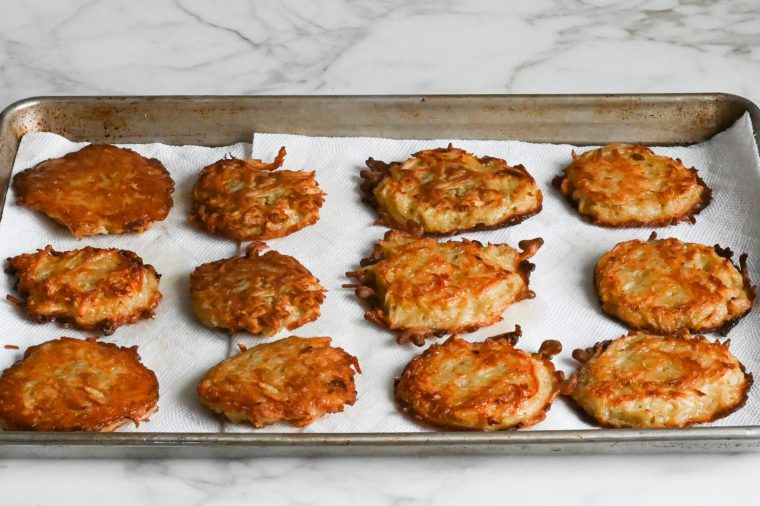
More Hanukkah Recipes You May Like
Latkes
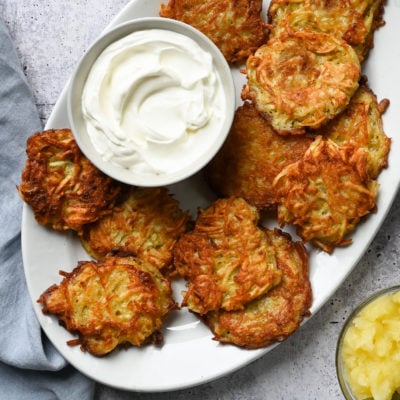
Ingredients
- 2 pounds russet potatoes (2 to 3 potatoes)
- 1 medium yellow onion, peeled (about the size of a baseball)
- 2 large eggs
- 1½ teaspoons salt
- 2 teaspoons baking powder
- ¼ cup all-purpose flour
- Vegetable oil, for frying
- Sour cream and applesauce, for serving
Instructions
- If using the oven method, preheat the oven to 425°F (220°C) and set two oven racks in the centermost positions.
- Make the Batter: Peel the potatoes, then coarsely grate them with the onion together using a food processor fitted with the grating blade—or by hand, using a box grater. Place the potato and onion mixture in a fine sieve over the sink or a large bowl and press down firmly with a wad of paper towels or a clean dishcloth to wring out excess moisture. Stir and repeat a few times with fresh paper towels until the liquid is mostly drained. Beat the eggs in a large bowl. Add the potato and onion mixture, salt, baking powder, and flour. Mix until evenly combined.
- Fry the Latkes:Stovetop Method: In a large cast iron or nonstick skillet over medium-high heat, heat about ¼ cup (60 ml) of oil. Once the oil is hot and shimmering, drop mounds of batter (about 3 tablespoons) into the hot pan (the batter should sizzle when you drop it in). Flatten the mounds slightly with a spatula. Reduce the heat to medium and cook until the bottom of the latkes are golden brown and crispy, about 5 minutes. Flip and cook until the second side is golden, another 4 to 5 minutes, adjusting the heat as necessary. Transfer the latkes to a baking sheet lined with paper towels to drain. Repeat with the remaining batter, adding more oil as necessary.Oven Method: Fill two heavy nonstick rimmed baking sheets with ½ cup oil each (see note). Place the pans in the oven for 10 minutes to heat the oil. Wearing oven mitts, very carefully remove the pans from the oven. Drop mounds of batter (about 3 tablespoons) onto the baking sheets, spacing the latkes about 1½ inches (4 cm) apart. Using the back of a spoon, press down on the latkes to flatten just slightly. Bake for 15 to 20 minutes, or until the bottoms are crisp and golden. Carefully remove the pans from oven and flip the latkes (tongs are the best tool as a spatula may cause oil to splatter). Place the pans back in the oven and cook until the latkes are crisp and golden brown all over, about 10 minutes more. Remove the pans from the oven and transfer the latkes to a baking sheet lined with paper towels.
- Serve the latkes warm with sour cream and applesauce.
Notes
- If using the oven method, you'll need two heavy nonstick rimmed baking sheets. Be sure they are truly nonstick and in good shape, otherwise the latkes will stick.
- Nutritional information was calculated assuming that approximately 2 tablespoons of the oil is absorbed into the latkes when frying.
- Make-Ahead/Freezing Instructions: Latkes are best served fresh from the skillet or oven, but they reheat well. Place them on a foil-lined baking sheet in a 375°F-oven for about 10 minutes, or until hot. They can also be frozen for up to three months; reheat directly from the freezer; allow a few extra minutes in the oven.
Nutrition Information
This website is written and produced for informational purposes only. I am not a certified nutritionist and the nutritional data on this site has not been evaluated or approved by a nutritionist or the Food and Drug Administration. Nutritional information is offered as a courtesy and should not be construed as a guarantee. The data is calculated through an online nutritional calculator, Edamam.com. Although I do my best to provide accurate nutritional information, these figures should be considered estimates only. Varying factors such as product types or brands purchased, natural fluctuations in fresh produce, and the way ingredients are processed change the effective nutritional information in any given recipe. Furthermore, different online calculators provide different results depending on their own nutrition fact sources and algorithms. To obtain the most accurate nutritional information in a given recipe, you should calculate the nutritional information with the actual ingredients used in your recipe, using your preferred nutrition calculator.
See more recipes:
Comments
Add a Comment Cancel reply
This site uses Akismet to reduce spam. Learn how your comment data is processed.
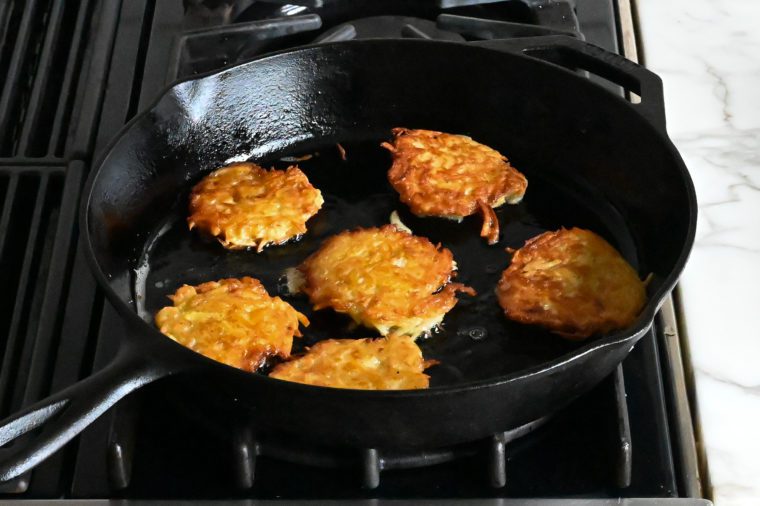
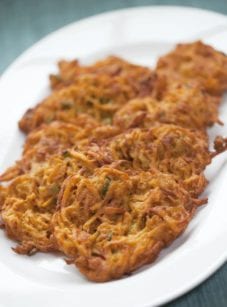
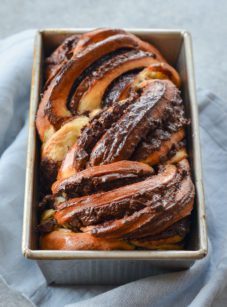

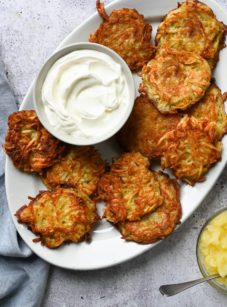
You did not indicate approximately how many this recipe yields if I make them using your measurements. Can you kindly provide that number? Thanks.
Hi Lauren, this yields approximately 18 latkes. Hope you enjoy!
These were wonderful with russet potatoes. Do you think they would work with sweet potatoes? Would you make any changes to the recipe? Thanks for all the great meals you have provided to my family!
Hi Julia, so glad you liked them! You can use this recipe for sweet potato latkes (minus the spices if you want, although they are incredible as is). If you’d like, you can use the oven frying technique used in this recipe. Hope you enjoy if you make them!